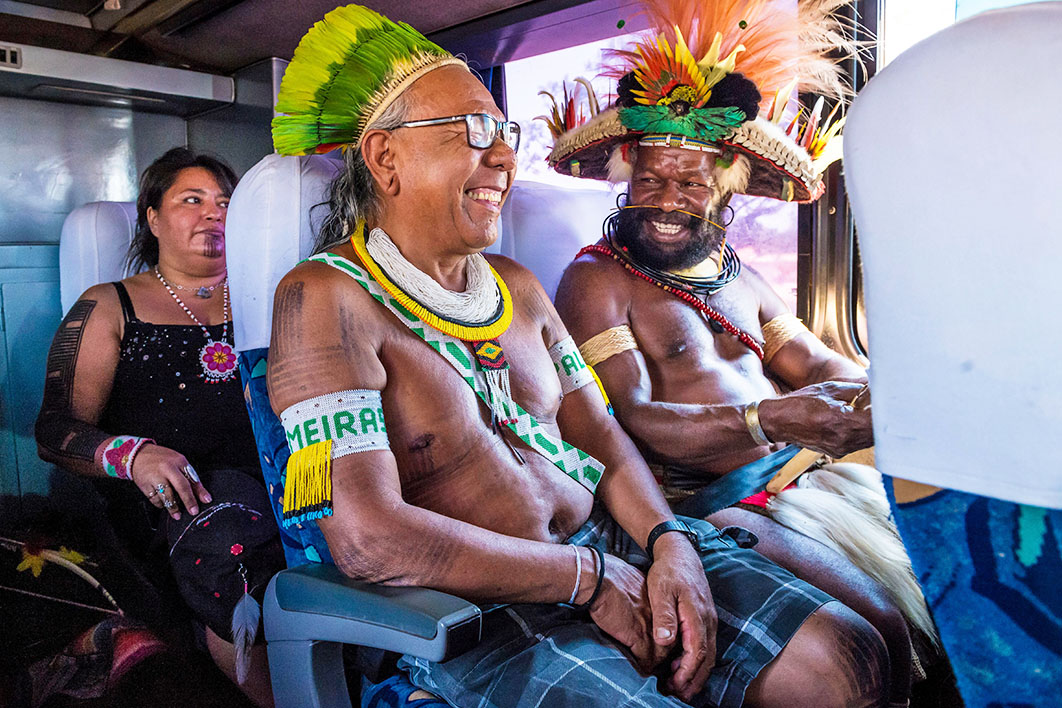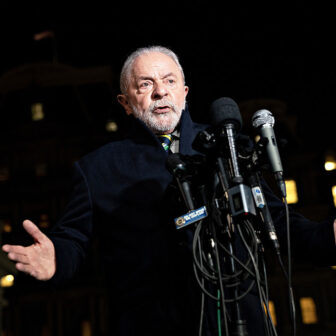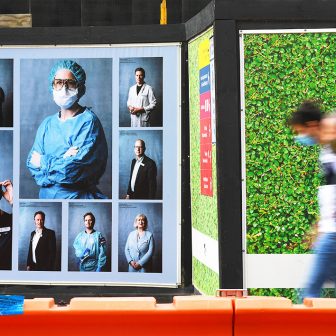When the iconic indigenous Brazilian leader Paulinho Paiakan died from Covid-19 in June, aged sixty-six, the pandemic was already having a significant impact on Latin American native communities. Paiakan had been hospitalised in the northcentral Amazon state of Pará, which is among the most badly affected regions of Brazil. As the chief of the Kayapo people — a nation of 10,000 settled along the Xingu River basin in Pará and neighbouring Mato Grosso — he had stood unyielding in the paths of miners and loggers.
Early the following month, sixty-three-year-old Santiago Manuin Valera, an elder of the Awajún people in the Peruvian Amazon, also fell victim to the pandemic. Back in April this internationally recognised defender of the Amazon had warned the Peruvian authorities of the emerging health catastrophe. When his words went unheeded, he called on indigenous chiefs to formulate their own health strategies to contain the pandemic. Communities went into voluntary isolation and access to their communities was blocked.
Among the 375 indigenous tribes of the Amazonian region of Peru, Ecuador, Colombia and Brazil, at least seventy-one are in voluntary isolation. The leading Amazonian indigenous organisation, the Interethnic Association for the Development of the Peruvian Rainforest, has closed its territories, as has the Achuar Nationality of Ecuador.
Héctor Requejo Longinote, mayor of Condorcanqui, a border province between Peru and Ecuador, ordered the closure of the roads that give access to the territory of the Awajún Wampis, a community of thousands living in the Amazon rainforest in the north of Peru. “Don’t let us die,” Requejo Longinote implored governments and health authorities in a television interview. And yet indigenous people are dying in this region.
Since Covid-19 made its first appearance, back in March, authorities have largely neglected the epidemiological vulnerability of the roughly twenty-eight million indigenous men and twenty-six million indigenous women of Latin America and the Caribbean.
In Brazil, for example, pandemic data shows that indigenous people — of which there are around 900,000 — become ill from Covid-19 and die at higher rates than the general population, simply because they are more likely to suffer from malnutrition, anaemia and obesity than the general population. According to UN figures, more than 50 per cent of indigenous Brazilians over the age of thirty-five have type 2 diabetes.
At the time of writing, 240 native Brazilians have died and another 2523 are infected, according to the Articulation of the Indigenous Peoples of Brazil, the country’s main indigenous federation. The first to die among them was fifteen-year-old Alvanei Xirinana, a survivor of childhood malaria and malnutrition. Xirinana symbolised the ever-present health emergency in Latin American indigenous communities, and the region’s history of introduced epidemics. Once it was the Spanish invaders who introduced devastating European viruses, including smallpox, flu and measles; today, the legacy of that conquest is still felt in high rates of illness.
If Covid-19 were not enough, a dengue epidemic is also having a devastating effect on indigenous communities across a swathe of Latin America. Around 16,000 people from fifty-five indigenous tribes in the Peruvian Amazon are estimated to be affected.
Indigenous people make up 30 per cent of Latin Americans living in poverty, though they account for only around 7 per cent of the population. Native communities — such as the Mapuche people in Chile, or the Qom nation in Argentina — don’t have access to drinking water, a natural resource now effectively owned by the forestry industry. They and other groups also lack access to health services and medicines.
Alvanei Xirinana was from the Yanomami people, the largest and most isolated indigenous group in South America, who live in the jungles and mountains of northern Brazil and southern Venezuela. Because of the spread of Covid-19, they have demanded that more than 20,000 garimpeiros — the illegal goldminers responsible for an estimated 10 per cent of the Amazonian deforestation — leave the area.
The garimpeiros have not only contaminated the Yanomami rivers; they have also introduced influenza, measles, pneumonia, malaria and other lethal diseases to which the Yanomami have little or no immunity. Between 1960 and 1980, for instance, 15 per cent of the Yanomami community was wiped out by a measles outbreak that was brought in, according to the NGO Survival International, by illegal gold seekers.
In a session of the UN Human Rights Council in Geneva in March, Yanomami leader Davi Kopenawa warned that his people “could be exterminated soon” if the interlopers were not kicked out. According to a study by the Brazilian NGO Instituto Socioambiental, Covid-19 could infect about 5600 Yanomami, or 40 per cent of their population.
Despite the epidemic, mining exploitation in remote areas has not ceased. In late March, the Brazilian government declared that the extraction, marketing, transport and supply of mineral products were essential activities. “Where there is indigenous land, there is wealth underneath,” Jair Bolsonaro, now president of Brazil, said in 2017.
“Mining companies are ignoring the real threats of the pandemic,” according to Voices from the Ground, a report produced in June by a coalition of indigenous human rights and nature rights NGOs. “Since March,” says the report, “the mining industry has been declared ‘essential’ in many countries around the world,” with “devastating results.”
In the copper and zinc mines of Antamina, in the northern Peruvian region of Ancash, more than 750 cases of Covid-19 had been recorded by mid June. “The mines should have worked at 50 per cent, but they have already returned to normal activity, although the pandemic is largely under way in Peru,” says Jaime Borda, executive secretary of the Muqui network in Peru’s Jauja province.
In Ecuador, one of the Latin American countries most affected by Covid-19, the government of Lenín Moreno considers mining to be among the country’s strategic economic sectors. Despite the health emergency, it has been allowed to continue operations. “Mining companies are taking advantage of the pandemic to continue to force their work on our territory,” says a member of the Shuar Arutam People’s Assembly. “They do not respect the state of emergency and continue to infiltrate our communities. This poses a greater risk to us.”
Settled in the southcentral Ecuadorian Amazon, the Waorani people warned about confirmed cases of Covid-19 among oil workers in the heart of its territory. Aware of the devastating impact of the pandemic on the elderly, Waorani leader Nemo Nenquimo pleaded with authorities to take care of the community’s “grandparents.” They are, he wrote, “the health experts whose knowledge has not been recorded… They teach us to take care of nature.”
Meanwhile, the roll call of deaths continues. Antonio Bolívar, who died at seventy-seven on 30 April, was known internationally for his role as the shaman Karamakat in the 2015 Oscar-nominated Colombian film Embrace of the Serpent. A tribal elder, he was one of the last survivors of the Ocaina people who have lived for centuries in the Colombian Amazon.
July’s death of Santiago Manuin Valera also highlighted the unfolding cultural tragedy. These indigenous elders, women and men, are the repository of culture, stories and traditions. They are the “grandparents,” the irreplaceable sources of oral wisdom that the pandemic might wipe out forever. •




